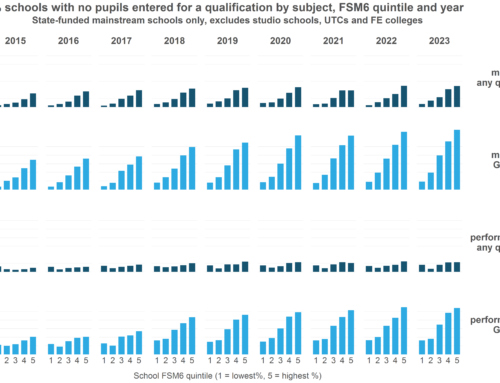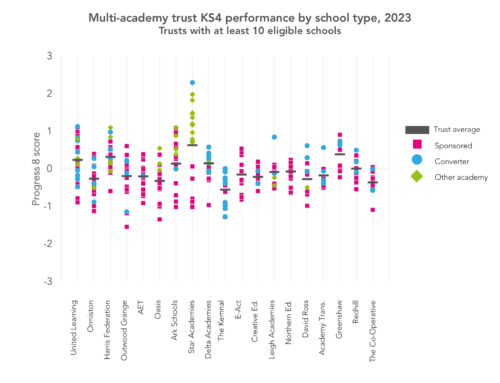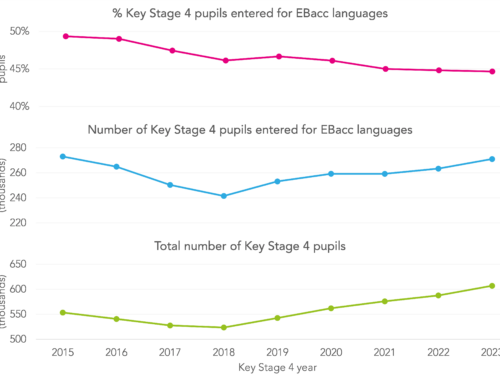This is the final post in a five part series on Ofsted. You can read the previous post here.
We have today published a new academic paper investigating how Ofsted inspection outcomes vary across inspectors with different characteristics. This has been supported by the Nuffield Foundation and uses data we have pulled together on approximately 30,000 school inspections conducted between September 2011 and August 2019.
You can read a full version of our academic working paper along with our responses to some FAQs about the research.
This final blog in the series looks at the relationship between lead inspector characteristics and short inspection outcomes of primary schools.
What are short inspections and how are they graded?
Short inspections were introduced by Ofsted in September 2015 in response to declining funding. They are reserved for schools judged to be Good during their previous inspection. As the name suggests, these inspections are, well, shorter (in terms of the total amount of inspection time devoted to them).
They also do not immediately result in a change to the Overall Effectiveness judgement of a school. Rather, under the current system[1], schools can receive one of four outcomes:
- Retain the Good grade (78% of outcomes between January 2018 and August 2019).
- A full inspection to be conducted in the next year due to progress (11%).
- A full inspection to be conducted in the next year due to concerns (10%).
- Immediate conversion with a new Overall Effectiveness judgement assigned (1%)
Interestingly, since their introduction, short inspections have become a major part of Ofsted’s inspection activity. For instance, our data suggests that more than half of all school inspections conducted by Ofsted between September 2016 and August 2019 were short inspections (Bokhove, Jerrim and Sims 2022: Table A1).
In this blog, we examine the relationship between lead inspector characteristics and the chances that the school had a “negative outcome” from their short inspection – defined as either (a) an immediate conversion to a full inspection resulting in an Inadequate or Requires Improvement judgement or (b) a recommendation that a full inspection be conducted in the next year due to concerns about the school.
Note that we focus on primary schools due to the larger sample size – and hence our ability to detect differences more precisely between groups.
How do short inspection outcomes of primary schools differ by lead inspector characteristics?
In short, we find differences by two lead inspector characteristics: gender and employment status (HMI versus OI).
Consistent with the results reported in our first blog male inspectors are found to be more lenient than female inspectors. After controlling for background factors, we find that 9.6% of short inspections led by a man resulted in a “negative outcome”, compared to 12.1% of those led by a woman. In other words, short primary inspections are about 25% more likely to result in a negative outcome if it is led by a female inspector.
And, consistent with the results from our second blog, short inspections led by OIs tend to result in more lenient outcomes than those led by HMIs. Even after controlling for background characteristics, we find that 8.8% of short inspections led by an OI resulted in a recommendation of a section 5 inspection to be conducted next due to concerns, compared to 13.1% of those led by an HMI. In other words, short primary inspections are almost 50% more likely to result in a negative outcome for the school if it is led by an HMI. (Of course, the same caveats about these OI/HMI differences hold here as discussed in the second blog in the series).
These results are summarised in Table 1.

Conclusions
Short inspections have become an increasingly important part of Ofsted’s portfolio. They are an interesting subset for us to consider, given that all schools that receive them were previously judged to be Good.
Yet our key findings replicate those from our analyses of Overall Effectiveness grades. For primary schools, there appears to be a difference in outcomes depending on whether the lead inspector is a man or a woman, or if the lead inspector is an OI or an HMI. This continues to hold true once we control – as far as possible – for background characteristics of the school, and thus at least partially accounting for the potential selection of different inspectors to different inspection tasks.
[1]: A different system was in place between September 2015 and December 2017 where schools either retained their Good grade or the inspection was immediately converted into a full inspection (where a new Overall Effectiveness grade could be assigned). This changed in January 2018 to the current system, due to the old system proving challenging logistically, particularly in terms of scheduling inspectors time at short notice when a conversion occurred.






Leave A Comment